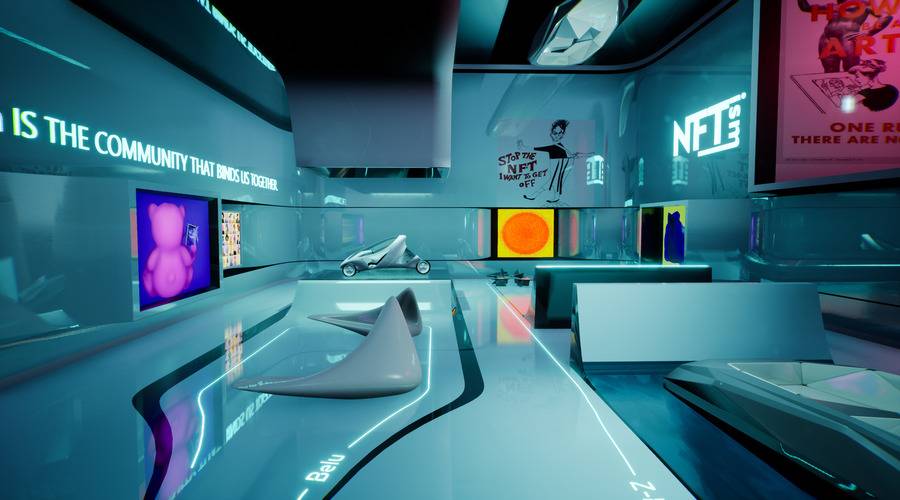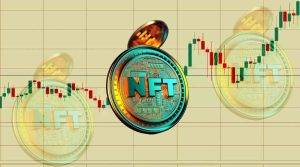NFTs and Science Fiction Literature: Exploring the Influence of Science on Creativity

NFTs and Science Fiction Literature: Exploring the Influence of Science on Creativity
Science fiction literature has long been a source of inspiration and creativity, imagining worlds and technologies beyond our current reality. In recent years, the emergence of Non-Fungible Tokens (NFTs) has provided a new platform for artists and creators to showcase their work and engage with a global audience. This article explores the intersection of NFTs and science fiction literature, delving into how NFTs have influenced the genre and how science fiction has embraced this new digital medium.
What are NFTs?
Before diving into the connection between NFTs and science fiction literature, let’s first understand what NFTs are. NFTs are unique digital assets that are stored on a blockchain, a decentralized and transparent ledger. Unlike cryptocurrencies such as Bitcoin, NFTs cannot be exchanged on a like-for-like basis. Each NFT holds distinct properties, making it one-of-a-kind and irreplicable. These properties make NFTs ideal for representing digital art, collectibles, and other unique creations.
NFTs, or Non-Fungible Tokens, are unique digital assets that exist on a blockchain, a decentralized and transparent ledger. Unlike cryptocurrencies such as Bitcoin or Ethereum, which are fungible and can be exchanged on a like-for-like basis, each NFT holds distinct properties that make it one-of-a-kind and irreplicable. These properties give NFTs their value and uniqueness.
NFTs have gained significant popularity in recent years, particularly in the art and collectibles market. Artists, musicians, and creators can tokenize their work by converting it into an NFT, attaching ownership and provenance to the digital asset. This allows for the creation of digital art, music, virtual real estate, virtual items, and more, which can be bought, sold, and traded on various NFT marketplaces.
The blockchain technology underlying NFTs ensures the authenticity, ownership, and scarcity of these digital assets. Each NFT is associated with a specific address on the blockchain, providing a transparent record of transactions and ownership history. This transparency and immutability make NFTs desirable for collectors, artists, and enthusiasts alike, as they offer a new way to own, showcase, and engage with digital creations in a secure and decentralized manner.
The Intersection of NFTs and Science Fiction Literature
The Rise of NFTs in the Art World
The art world has been significantly impacted by the rise of NFTs. Artists can now tokenize their creations, attaching ownership and provenance to digital artworks. This shift has democratized the art market, enabling artists to directly connect with their audience and monetize their work. Within the realm of science fiction literature, NFTs have become a vehicle for visual storytelling, with artists creating unique and immersive digital pieces inspired by sci-fi themes. NFTs have experienced a significant rise in the art world. Artists can now tokenize their creations as NFTs, allowing for ownership, provenance, and direct engagement with collectors. This shift has democratized the art market, providing new opportunities for artists to monetize their work and connect with a global audience.
Science Fiction Themes in NFT Artwork
NFT art often draws inspiration from science fiction literature, encompassing futuristic landscapes, alien worlds, and advanced technologies. Artists can capture the essence of science fiction narratives through their visuals, exploring themes of exploration, technological advancements, and the human condition. By leveraging NFT platforms, artists can showcase their creations and allow enthusiasts to collect and own these unique pieces of science fiction-inspired art.
Exploring the Metaverse through NFTs
The concept of the metaverse, a virtual reality space where individuals can interact and engage with digital assets, has gained traction in recent years. NFTs play a crucial role in the development of the metaverse, enabling users to own and trade virtual assets within these immersive environments. Science fiction literature often depicts virtual worlds and alternate realities, and NFTs provide a tangible link between these narratives and the digital realm.
The Impact of NFTs on Science Fiction Literature
Fostering Creativity and Innovation
NFTs have opened up new avenues for creativity and innovation within science fiction literature. Writers can collaborate with visual artists and musicians to create immersive storytelling experiences that transcend traditional mediums. By leveraging NFTs, authors can bring their stories to life through digital collectibles, interactive elements, and augmented reality experiences. This fusion of literature and technology enhances the reader’s engagement and offers a unique and dynamic narrative.
Empowering Artists and Writers
Traditionally, science fiction authors and artists have faced challenges in reaching their audience and monetizing their work. NFTs provide a decentralized marketplace that empowers creators by eliminating intermediaries and enabling direct interactions with fans and collectors. Through NFTs, authors can sell exclusive editions of their books, offer unique behind-the-scenes content, and engage in crowdfunding campaigns for their upcoming projects. This newfound financial support and direct connection with fans enhance the sustainability of science fiction literature.
Redefining Ownership and Intellectual Property
NFTs have revolutionized the concept of ownership and intellectual property within the creative industry. With NFTs, creators can embed royalties into their digital assets, ensuring they receive a percentage of future sales whenever their work is traded. This mechanism enables authors to have ongoing revenue streams from their books, short stories, and other literary creations. Additionally, NFTs provide an immutable record of ownership, protecting authors’ rights and preserving their legacy within the digital landscape.

NFTs and Science Fiction: A Collaborative Future
NFTs as Inspiration for Science Fiction Stories
The emergence of NFTs has sparked inspiration for science fiction authors, fueling their imagination and prompting new story ideas. The concept of unique digital assets, virtual worlds, and decentralized ownership can be integrated into science fiction narratives, exploring themes of identity, authenticity, and the impact of technology on society. Authors can weave tales that delve into the consequences and possibilities that arise from the intersection of NFTs and science fiction.
Exploring NFT Collectibles within Sci-Fi Narratives
Science fiction literature often incorporates the concept of collectibles, from futuristic artifacts to alien relics. NFTs provide an opportunity to bring these collectibles to life in the digital realm. Authors can integrate NFTs into their stories as interactive elements, allowing readers to discover and collect virtual items that hold significance within the narrative. This immersive experience enhances reader engagement and provides a unique way to explore the world of science fiction.
Engaging with the Science Fiction Community through NFTs
NFTs foster a sense of community and engagement within the science fiction genre. Authors can interact with their readers through exclusive NFT releases, virtual events, and behind-the-scenes content. Fans can support their favorite authors by collecting limited-edition NFTs, attending virtual signings, and participating in interactive storytelling experiences. This symbiotic relationship between authors and readers strengthens the science fiction community and creates a collaborative ecosystem.
Challenges and Considerations in the NFT-Sci-Fi Landscape
- Accessibility and Inclusivity
While NFTs offer exciting possibilities for science fiction literature, accessibility and inclusivity remain important considerations. As the technology evolves, it is crucial to ensure that NFT platforms are user-friendly, allowing authors and readers of all backgrounds to participate. Efforts should be made to address barriers such as transaction costs, technical complexities, and digital divide issues to ensure equal opportunities for creators and readers alike.
- Environmental Impact and Sustainability
The environmental impact of blockchain technology, which underlies NFTs, has raised concerns regarding sustainability. As the demand for NFTs grows, so does the energy consumption required for blockchain transactions. It is essential for the NFT community to prioritize sustainable practices, explore eco-friendly blockchain solutions, and offset the carbon footprint associated with NFT creation and transactions. Balancing technological innovation with environmental responsibility is crucial for the long-term viability of the NFT-science fiction landscape.
- Balancing Originality and Copyright Issues
With the rise of NFTs, the issue of originality and copyright protection becomes more complex. While NFTs provide a transparent record of ownership, ensuring that creators receive recognition and compensation, it also raises questions of unauthorized use and infringement. Clear guidelines and frameworks need to be established to protect authors’ intellectual property rights while fostering a collaborative and open ecosystem for creativity.
Conclusion
The convergence of NFTs and science fiction literature opens up a world of possibilities for both creators and enthusiasts. NFTs provide a platform for artists and authors to showcase their work, redefine ownership, and engage with a global audience. By integrating NFTs into science fiction narratives, authors can create immersive and interactive experiences that captivate readers and explore the impact of technology on society. However, it is essential to address challenges such as accessibility, sustainability, and copyright issues to ensure the long-term success of this collaboration.
FAQs
FAQ 1: How can NFTs benefit science fiction authors?
NFTs benefit science fiction authors by providing new revenue streams, enabling direct engagement with fans, and fostering collaboration with other artists and creators.
FAQ 2: Are NFTs limited to visual artwork only?
No, NFTs can represent various forms of digital assets, including written works, music, virtual items, and more.
FAQ 3: Can NFTs create new revenue streams for science fiction creators?
Yes, NFTs allow authors to monetize their work through the sale of unique editions, royalties, and exclusive content, creating new revenue streams.
FAQ 4: What role does blockchain technology play in NFTs?
Blockchain technology provides the decentralized and transparent infrastructure for NFTs, ensuring ownership, provenance, and secure transactions.
FAQ 5: How can individuals participate in the NFT market?
Individuals can participate in the NFT market by creating, collecting, buying, and selling NFTs through various platforms and marketplaces available.

I’m known as one of the best crypto authors because I take time to understand the technology and write in a way that is easy for others to understand. I can simplify complex concepts and my writing style is engaging. My articles have been featured on some of the top crypto sites and I’mregularly sought out by readers for my insights on the latest news. I’m also a speaker and have discussed crypto at various conferences. If you’re looking for someone who can help you make sense of the ever-changing world of cryptocurrency, then you can get in touch with me.



